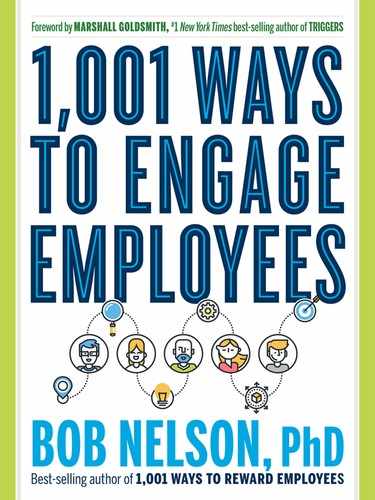1,001 WAYS TO ENGAGE EMPLOYEES
PREFACE
Every company today needs to obtain extraordinary results from ordinary people in order to survive, let alone thrive.
This book has a simple premise: Show people what employee engagement looks like in practice. Generally speaking, employee engagement captures the spirit, drive, and discretionary energy on the part of all its employees. It's one of those fuzzy terms in corporate America—like “employee empowerment” before it and “employee satisfaction” before that—meant to address all things, and yet, as a consequence, addresses nothing. Over the last two decades, most organizations have launched engagement initiatives or programs at their worksites. What those efforts focused on depended primarily upon how the organization measured the concept of engagement to begin with, often using the dimensions advocated by the human resources consulting firm they were working with at the time.
To help companies increase the level of employee engagement in their organization, I wanted to create a resource that started with the primary variables that most drive employee engagement, prioritize those variables in order of their greatest influence on the topic, and then identify real-life examples, techniques, and best practices of what those categories look like in practice from companies of all types and sizes. This would result in a resource that could serve as a starting point for organizations who wanted to actually move the needle in creating greater employee engagement in their organizations, not just measure the topic year after year.
After all, we already know there has been very little overall change in the number of engaged and disengaged employees over the last twenty or so years. Only three of every ten workers today is “engaged,” giving full discretionary effort on his or her job today—a statistic that, according to the Gallup Organization, pretty much hasn't changed in recent decades.
About half of all employees are “disengaged” at work, that is, going through the motions but not committed to giving their best effort in their jobs, and the remainder of employees (18 percent) are “actively disengaged,” even to the point of being counterproductive to the goals of the organization. Since committed employees reportedly deliver 57 percent more discretionary effort than uncommitted ones, driving greater employee engagement is critical for all organizations today. Doing it well can make the difference in driving critical aspects relevant for achieving an organization's mission and goals, its ability to attract and retain talent, and its desired financial results.
THE QUEST FOR ENGAGEMENT
Employee engagement has become the holy grail in the management of human resources. Simply stated, employee engagement is the alignment of individual and organizational goals and values to better drive both business results and personal aspirations. Ever elusive, it seems the more companies strive to attain it, the more it slips from their grasp. But the quest continues because the topic has proven to be too important to ignore.
Without an engaged staff, managers have a tough time accomplishing much—let alone the best work possible. Human resources consulting company WillisTowersWatson has noted: “Four out of every five workers are not delivering their full potential to help their organizations succeed” and the Gallup organization has estimated that disengaged employees cost the United States $450 billion annually.
In order to achieve or surpass their business objectives, companies must make sure their employees are actively engaged, inspired, and generally feel excited about their work. According to Gallup, if organizations are able to create a culture of engagement, they stand to have employees that are:
- 480 percent more committed to helping their company succeed.
- 250 percent more likely to recommend improvements.
- 370 percent more likely to recommend their company as an employer.
If employees are engaged in their work, they have a greater desire to work harder, to be more productive, and to be more responsible in completing work to the best of their ability. When organizations make employee engagement a priority, they can obtain increased organizational profitability, productivity, flexibility, and employee retention, and are better able to attract talent as well. Employee engagement also creates trust between the organization and its employees so that both parties can better work together to be adaptive to changing needs and circumstances of the environment in which they operate.
This book focuses on a compilation of the primary drivers of employee engagement, prioritized in order of their impact on the topic. More importantly, it will show you what these drivers look like in practice through specific examples taken from real organizations that today are having a positive impact on these dimensions. With this book you, too, can readily learn and apply the same ideas, techniques, and best practices in your organization or work group.
Like the other 1,001 Ways books I've written before this one, I have sought to boil down the topic to the essence of what it looks like in practice through the power of real-life examples. Whether you manage just one person or are responsible for thousands, this book can help you zero in on the specific behaviors and actions that matter the most in inspiring your employees to be their best each day, every day. Best of luck in your pursuit!
—Dr. Bob Nelson
San Diego, California
